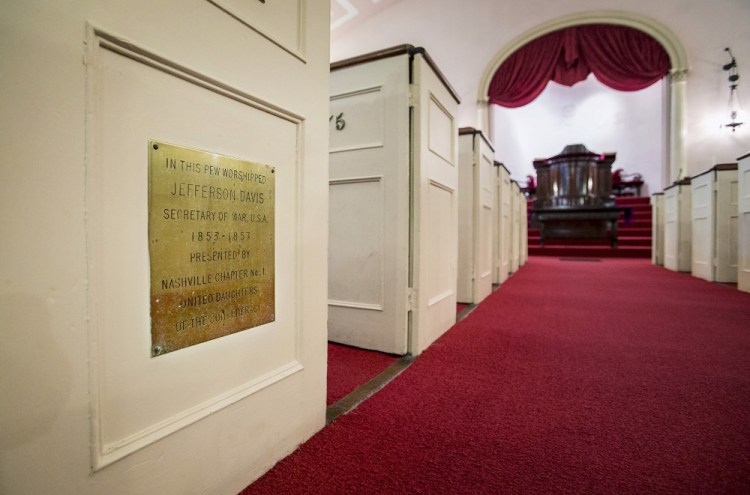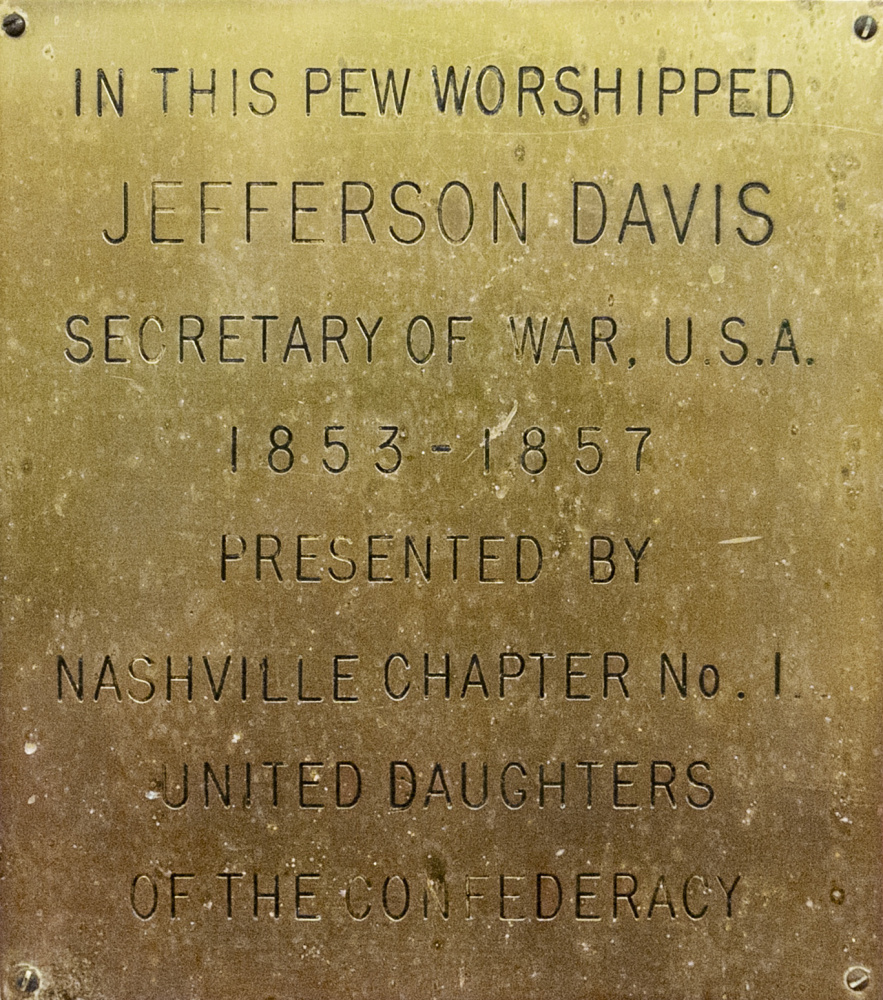Go looking for Maine monuments to the Civil War, and you will find roughly 170 permanent memorials to Union soldiers that dot the state’s town squares and cemeteries.
But an enshrinement to a Confederate, deep in Joshua Chamberlain territory? Those are harder to find, and their days could be numbered.
Nailed to a pew inside the First Parish Unitarian Universalist Church on Congress Street in Portland is a rectangle of brass honoring Jefferson Davis, president of the Confederacy, possibly the only memorial in Maine dedicated to a leader of the soldiers in gray.
But a week after deadly violence erupted at a rally in Charlottesville, Virginia, and in the midst of impassioned discussion over the removal of statues dedicated to Confederate leaders, First Parish is considering whether to remove the plaque, which has been, until now, mostly an oddity to church leaders, who have puzzled for years over how it got there.
A second plaque at Bowdoin College honors 19 alumni who fought for the Confederacy in the Civil War, including Davis, who received an honorary degree from Bowdoin. Bowdoin President Clayton Rose announced Saturday that artifacts “directly tied to the leadership of a horrible ideology are not meant for a place designed to honor courage, principle, and freedom,” and that the plaque would be moved into the college’s archives.
While Maine has not seen the same level of anger or anguish over how to treat – or remove – statues of significant historical figures, it has had to grapple with its own racial history when honoring figures that are significant to the state.
A statue of Portland’s founder, George Cleeve, was caught in controversy about 15 years ago when city officials refused to accept the statue because Cleeve was rumored to have owned a “colored servant” when he and his business partner Richard Tucker arrived on the peninsula in 1633, even though there was no proof that he ever owned a slave.
In Kittery this year, a new historical marker was dedicated to Gen. William Whipple, the only Maine native to sign the Declaration of Independence. Whipple owned a slave before the war for independence, but later expressed his support for emancipation.
A CONFEDERATE CONNECTION
While other Civil War monuments stand in hallowed spaces or depict revered men, the plaque in Portland does neither. Attached to a pew almost at ankle height, it is unreadable from eye level. The message blends into the many other memorials that dot the pews and walls of the historic church.
“In this pew worshipped Jefferson Davis secretary of war, U.S.A., 1853-1857,” it reads. “Presented by the Nashville Chapter No. 1 United Daughters of the Confederacy.”
Although Davis never lived in Maine, he vacationed here for two summers, in 1857 and 1858, the only time he is believed to have been in Maine.
“What strikes me about it is this is hardly a significant accomplishment in Davis’ life. What a weird thing to do, you know?” said Janet Puistonen, a First Parish trustee, who has been puzzling since the Charlottesville rally over why and how the plaque got there. Davis’ time in Maine is barely a footnote in his life.
After he served as secretary of war under President Franklin Pierce until 1857, Davis returned to his seat as a senator from Mississippi. After an arduous winter in which he caught a serious cold, Davis and his wife spent a few months enjoying Portland’s summer to recuperate.
His visit was well documented at the time – a band serenaded him outside his Portland hotel, and Davis, known for his oratory, spoke before multiple groups, including local Democrats. He received an honorary degree from Bowdoin College while attending graduation exercises there in 1858, and was even a late addition to a bill of speakers at a high school graduation.
Erin Blakemore, a Colorado journalist and historian, said the donation by the Daughters of the Confederacy so far from the battlegrounds where the Civil War was fought fits into the organization’s campaign over decades, starting just after the war’s end, to redefine Confederate history in more favorable terms to the South and create a narrative of the “lost cause.”
“I also see it as a territorial move on the part of the UDC, to say ‘Hey, we’re here, and this narrative is here,'” Blakemore said. “One of the weirdest things, especially when you get to these higher-level figures (such as Davis), people wanted to reconstruct, like, every minute of these people’s lives. There is this PTA, ladies auxiliary, Junior League-type of aspect to these activities. I don’t know if it’s sinister necessarily, but these small ways, one plaque at a time, one pew at a time, is how these narratives become part of our culture.”
Blakemore said newspaper clippings from the Baltimore Sun and the Atlanta Journal Constitution from October 1952 tell how Glenn Long, of Newton, North Carolina, then the president-general of the United Daughters of the Confederacy, presented the brass slab, proudly noting it was the only one of its kind in the Northeast, save for a marking in Brooklyn honoring Confederate generals Robert E. Lee and Stonewall Jackson.
Long said Davis was described on the inscription as Secretary of War because “that’s what he was when he attended services here,” she told The Associated Press, according to the Oct. 20, 1952, edition of the Baltimore Sun.
The marker was accepted by First Parish’s then-pastor, the Rev. Alexander Winston, who said at the dedication service that Davis was one of the nation’s greatest men, according to the report. Winston’s sermon that day was titled “In Christ, No North or South.”
On Friday, a woman who identified herself as an archivist at the United Daughters of the Confederacy national office in Virginia refused to give her name and did not return a call seeking comment on the plaque.
OTHER CONTROVERSIES OVER MAINE FIGURES
The plaque is not the only commemoration in southern Maine of a historical figure with connections to slavery.
The marker dedicated to Whipple in Kittery mentions that his views of slavery evolved over time. He owned a slave and transported at least one shipload of slaves to the Colonies before renouncing slavery later in his life.
Maine State Historian Earl Shettleworth said Cleeve, Portland’s founder, had an indentured servant, not a slave. At the time of the controversy over the placement of Cleeve’s statue, his descendants presented evidence indicating that the man purported to be his slave, Oliver Weekes, was actually a sailor hired to assist Cleeve’s settlement in Portland. The council, however, was unpersuaded and public outcry scuttled plans to celebrate Cleeve, whose statue now stands on private property near Portland Harbor.
A year after Cleeve’s statue was moved to near the water’s edge behind a chain-link fence at Portland Yacht Services, the city refused to allow the Amistad replica ship to dock there. The Amistad was a 19th-century tall ship that was taken over by slaves and depicted in a movie of the same name.
CHURCH PONDERS ITS HISTORY
Whether First Parish can easily remove the plaque dedicated to Jefferson Davis has not been decided. As the oldest place of worship in the city with roots that go back to the 17th century, the church has been added to the National Register of Historic Places.
Making changes to the building, large or small, is a complex process.
Puistonen said that immediately after bringing the plaque to the attention of other trustees and church leaders, the consensus has been to remove it. Davis’ values would have been at odds with the church’s values, both then and now, but she said no action has been decided upon, and she hopes only to start the conversation.
“The abolition movement was heavily, heavily associated with Unitarians,” Puistonen said. “So why on earth would (Davis) choose that as the place to attend is a puzzlement.”
Today, the First Parish congregation is active in the Black Lives Matter movement, supports equal rights for all regardless of gender identity or sexual orientation, and welcomes people of all races, ethnicities and faith backgrounds to its services.
“We have a very historic church and there are people who are memorialized on the walls, including one of the early ministers, who owned a slave,” Puistonen said. “When you have that much history, you have the good and the bad. But as far as I can tell, Jefferson Davis didn’t really have any history with the church. So it’s one thing for us to own our early reprobate ministers. It’s another thing to own Jefferson Davis.”
Matt Byrne can be contacted at 791-6303 or at:
mbyrne@pressherald.com
Twitter: MattByrnePPH
Send questions/comments to the editors.





Success. Please wait for the page to reload. If the page does not reload within 5 seconds, please refresh the page.
Enter your email and password to access comments.
Hi, to comment on stories you must . This profile is in addition to your subscription and website login.
Already have a commenting profile? .
Invalid username/password.
Please check your email to confirm and complete your registration.
Only subscribers are eligible to post comments. Please subscribe or login first for digital access. Here’s why.
Use the form below to reset your password. When you've submitted your account email, we will send an email with a reset code.